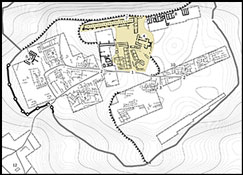Crossref Citations
This article has been cited by the following publications. This list is generated based on data provided by
Crossref.
Quirós, Juan Antonio
Campana, Stefano
and
Saito, Ken
2022.
Magnetic prospection at Aistra (Álava) and Peña Amaya (Burgos): Towards a new diagnostic paradigm for early mediaeval Iberia.
Archaeological Prospection,
Vol. 29,
Issue. 1,
p.
3.
Diarte-Blasco, Pilar
Castro-Priego, Manuel
and
Olmo-Enciso, Lauro
2022.
Urban Defence and the Visigoths: New Light on Fortification Design and Technology from the Royal City ofReccopolis(Guadalajara, Spain).
Medieval Archaeology,
Vol. 66,
Issue. 1,
p.
30.
Martínez Jiménez, Javier
2022.
El consumo de agua en la construcción romana con morteros de cal: un método de cálculo.
Arqueología de la Arquitectura,
p.
e131.
Stevens, Susan T.
2022.
Becoming medieval: cities on the Iberian peninsula and in North Africa - S. Panzram, and L. Callegarin, eds. 2018. Entre civitas y madīna. El mundo de las ciudades en la Península Ibérica y en el norte de África (siglos IV-IX). Pp. XVI + 393. Madrid: Casa de Velázquez. ISBN 978-84-9096-216-9..
Journal of Roman Archaeology,
Vol. 35,
Issue. 1,
p.
372.
Castro-Priego, Manuel
Diarte-Blasco, Pilar
and
Olmo-Enciso, Lauro
2023.
Coins from the multi-stratified medieval site of Reccopolis: analysis of long-term numismatic records.
Journal of Medieval Iberian Studies,
Vol. 15,
Issue. 3,
p.
427.
Martínez Jiménez, Javier
and
Checa Herráiz, Joaquín
2023.
The water cycle in Reccopolis.
Journal of Roman Archaeology,
Vol. 36,
Issue. 1,
p.
157.
Rębkowski, Marian
García-Contreras Ruiz, Guillermo
Martínez Álvarez, Cristina
Ryndziewicz, Robert
and
Filipowiak, Wojciech
2024.
Topography and buildings of an early Islamic Andalusi city: evidence for Madīnat Ilbīra from excavations and ground penetrating radar.
Journal of Medieval Iberian Studies,
Vol. 16,
Issue. 3,
p.
285.
Martínez Jiménez, Javier
2024.
City, Citizen, Citizenship, 400–1500.
p.
29.
